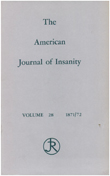Continuities between psychiatric disorders in adolescents and personality disorders in young adults
Abstract
OBJECTIVE: Personality disorders are a major mental health problem, but little information about their etiology and natural history is available. This study examined continuities between axis I disorders in adolescents and personality disorders in young adults. METHOD: The authors interviewed 145 young adults (mean age, 19.6 years) who had been diagnosed with a variety of DSM-III emotional and disruptive disorders during adolescence (mean age, 13.7 years). The Personality Disorder Examination was used to establish whether the subjects currently suffered from personality disorders. RESULTS: Subjects who had had disruptive disorders during adolescence showed high rates of all types of personality disorders (40% had a personality disorder at follow-up), while subjects who had had emotional disorders had a lower rate of personality disorders (12%). Men were more likely to have cluster A personality disorders, and women were more likely to have cluster C personality disorders. Disruptive diagnoses were associated with cluster B personality disorders, but emotional disorders did not show an association with cluster C personality disorders. Oppositional disorder did not increase the likelihood of passive-aggressive personality disorder. There was an association between attention deficit disorder with hyperactivity and borderline personality disorder. CONCLUSIONS: The rate of personality disorders was lower among young adults who had had emotional disorders during adolescence than among those who had had disruptive disorders, suggesting either that treatment for emotional disorders is more effective or that the personality psychopathology in these adolescents is not as severe as that in adolescents with disruptive disorders.
Access content
To read the fulltext, please use one of the options below to sign in or purchase access.- Personal login
- Institutional Login
- Sign in via OpenAthens
- Register for access
-
Please login/register if you wish to pair your device and check access availability.
Not a subscriber?
PsychiatryOnline subscription options offer access to the DSM-5 library, books, journals, CME, and patient resources. This all-in-one virtual library provides psychiatrists and mental health professionals with key resources for diagnosis, treatment, research, and professional development.
Need more help? PsychiatryOnline Customer Service may be reached by emailing [email protected] or by calling 800-368-5777 (in the U.S.) or 703-907-7322 (outside the U.S.).



